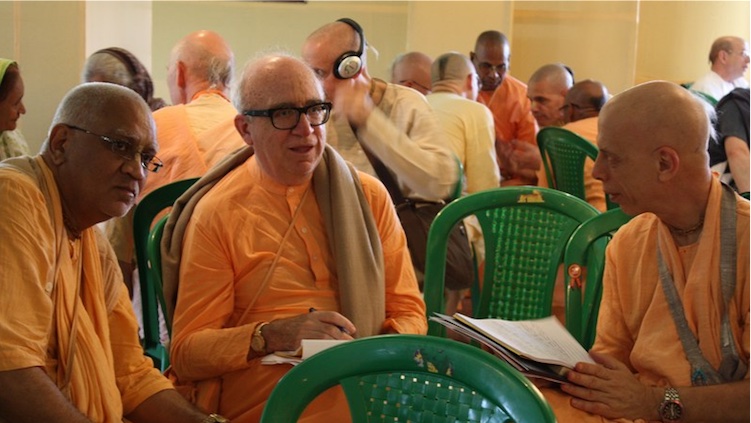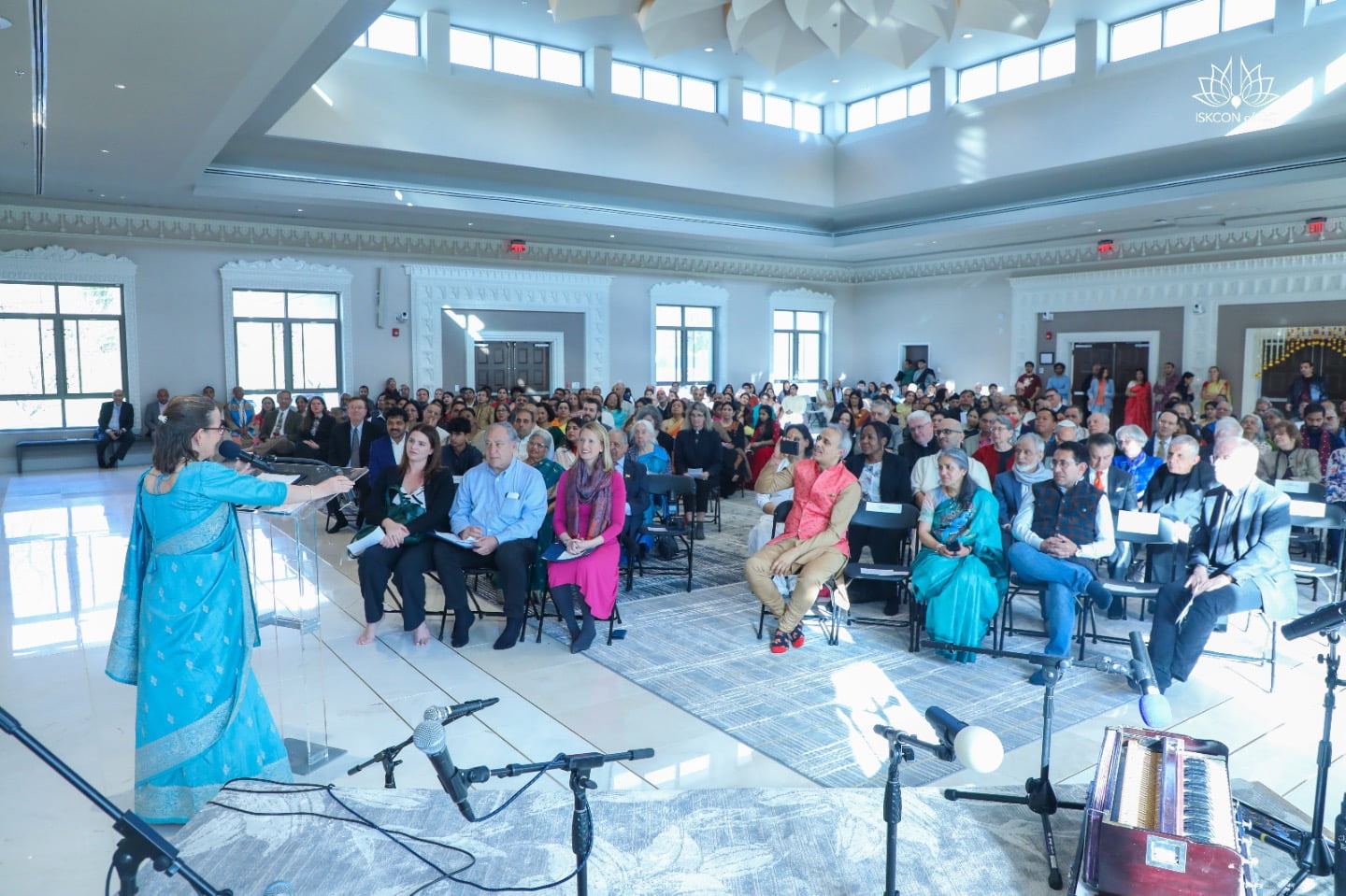Days Two and Three of ISKCON GBC, Sannyasi and Guru Sanga
By Indulekha Sakhi Dasi | Feb 17, 2017

Problems. Complications. Difficulties. We all have them. Usually they occur 365 days a year. And 366 days each leap year. Being a leader means dealing with the added responsibility of societal and institutional issues and finding viable solutions as well. But the first step in solving a problem is recognizing that there is one.
On the second and third days of the GBC, sannyasi and guru sanga, the participants began to untie this Gordian knot. The morning session of the second day started with a report back by the sanga participants. The three topics tackled by the groups were issues that had been identified from their discussions the previous day. The first subject was “substance versus form”. There was a general feeling that sometimes in ISKCON substance is lost over form. The group explained a number of encouraging ways to deal with this. These included, a Srila Prabhupada founder-acarya seminar so that subsequent generations can have a better understanding of him, evolving a culture that focuses on developing human qualities such as more compassion and kindness, and ensuring that the nine processes of bhakti are better understood by the devotee community. The group surmised that spiritual education, character formation and spiritual insight would boost substance over form.
The obstacles that could be encountered, they reported, were a lack of resources (time and money), and some of the cultural dynamics already present in ISKCON.
The second group spoke about leadership. The main stumbling block they considered was a lack of faith in ISKCON leadership. Some of the solutions presented were: a system of checks and balances and improved accountability that will engender trust in those in positions of authority. Other options included using tools such as the ISKCON News website to promote better communication.
The third group discussed the reading of Srila Prabhupada’s books and how devotees can be stimulated to spend more time reading. Ideas that were presented were promoting Bhakti Sastri, a seminar showcasing the benefits of reading, a reading mela (gathering) to encourage reading, awards for those excelling in reading and emphasizing the need for reading. Some impediments that devotees face are a lack of time and a deficiency in taste for reading.
In the afternoon session there was a presentation by Kaunteya Das on the three ecosystems in ISKCON. The three primary ecosystems in ISKCON are the guru-disciple, the social, and the organization. Previously, in Vedic times the spiritual community was based on a guru-disciple relationship with little interaction between the broader social structure and the religious organization. Nowadays, however, the three ecosystems must be balanced to retain a healthy ISKCON. Participants were asked to list tensions in the three ecosystems, examine these tensions looking for the root cause, and how to promote a stronger devotee community.
One of the stressors mentioned was resources (such as money, manpower, time facilities) or the lack thereof. The root causes of problems involving resources were identified as insensitivity to the needs of others, a false sense of proprietorship, false ego, lack of control policies for resources, lack of common vision, and cultural differences when dealing with people from different backgrounds.
Another problem identified was neglecting local temple needs in favor of prioritizing the need of an individual guru or prioritizing the needs of the temple at the expense of the guru-disciple relationship. Some of the root causes of this were gurus having personal projects that need time and money, donors giving to sannyasis more readily than to others, and lack of respect for local leaders. This stems from a lack of trust, lack of transparency, no istha-gosthis (community meetings), slacking of sadhana and lack of understanding. Conversely sometimes local leaders may stress projects over people.
On day three the discussions centered on how sannyasis and gurus and GBCs can become more effective.
The sanga participants concurred that sannyasis can become more effective by contributing donations they collect in an area to the local temples, taking prasada with devotees, being more transparent, giving more time to temple devotees and closer collaboration with temple authorities.
GBCs can increase their effectiveness by being more accessible, being more responsive to the problems of devotees, visiting their temples more frequently, getting to know devotees, informing devotees about GBC resolutions and proactively asking for their input.
Various sannyasis gave their comments on these issues.
Devamrita Swami said, “Sannyasis in general do need downtime, to recharge and not be in the public eye. Communicate that downtime. If you just disappear on your own, there will be suspicion. Everyone needs this recharge time and it is very important how you go about it, but the need is there.”
Bhakti Caitanya Swami said, “I try to pace myself, and get sufficient rest. You become dysfunctional otherwise. I recommend a guru retreat.”
Janardana Swami said, “Always keep travelling and preaching constantly and always with an assistant. Encourage the disciples to come to the classes regardless of whoever is giving the class.”
Bhaktimarga Swami, “Walking is a nice balance, off the beaten path…”
Mahadyuti Prabhu, “If my health is not good everything else goes downhill. Srila Prabhupada gave three priorities: health, sadhana, service.”
Janananda Swami, “Associate with devotees confidentially to tear out those anarthas. The essence for me is to look at my heart”
Radha Krishna Das, “What we can do is to put responsibility on ourselves not to act in a way that we come in conflict with our godbrothers or senior devotees. Self-restraint. Always have loving relationships, restrain your mind from thinking negatively about anybody, think positively, and appreciate other devotees. At the same time, whatever disagreement there will be, philosophical or managerial, keep that in a separate basket. Don’t let it affect how you relate to one another.”
Niranjana Swami said, “Deeper commitment to those who come to me as a disciple, to serve me means serving Srila Prabhupadas’s institution. Instilling it in disciples’ hearts to the point that if they whimsically leave services entrusted by local authorities that would be displeasing to me. That’s what I could do to contribute to correct misperception about gurus.”
Sesa Das, the GBC chairperson, concluded the sanga by reminding all the gurus, sannnyasis and GBCs present of the need to work cooperatively to prepare for the future when the current leadership will be handing over authority to the next generation of leaders.












